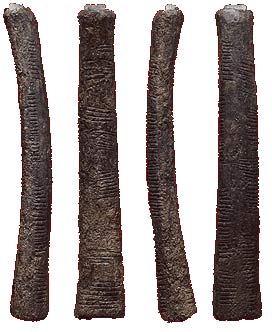New discovery about the cradle of human mathematics
Belgian scientists say they have deciphered the remains of Ishango bones discovered by a Belgian geologist half a century ago in Africa. Accordingly, the mathematical cradle of humanity lies in Africa.
Ishango bone burning, also known as Ishango stick, dates back to nearly 23,000 years before our era. This is the oldest proof of the application of mathematics in human history. The 10.2 cm long bone of an animal has not been identified. At one end of the bone is attached a piece of quartz.
Many bone markings are organized in an organized way, divided into groups of 3 or more columns. For years, scientists have invested a lot of time to study the meaning of those marks. Ishango is currently on display at the Sciences Naturelles museum in Brussels, Belgium.
The Belgian archaeologist Jean de Heinzelin de Braucourt found this bone in 1950 on the shores of Lake Édouard in the Ishango region of the Congo region of Belgium, today the Democratic Republic of Congo, near Ouganda.

Burning Ishango bones (Photo: Research.att.com)
Earlier, some people thought of a moon calendar, an arithmetic game or an abacus from the bone markings. But the results of a recent study tend to be skewed toward the final assumption. This is because of the second bone fragment at Ishango, which has been discovered by scientists.
Both bones are the mathematical objects of a people who do not know how to calculate the decimal system like modern humans, but they know based on the basis of numbers 6 and 10. mind that this is a typical counting in Africa.
Jean de Heinzelin was the first to regard this as an interesting fantasy about human history of mathematics. He assimilated it as an arithmetic game and gave an arbitrary order to different markers. The first column is a, the second column is b and the third column is c and gives a more convincing argument than the previous assumption.
The author of this important finding argues that column a is compatible with a basic counting factor of 10, which comes from the fact that the marks on it are grouped like the number 10 + 1, 10 - 1, and the column c corresponds to the basic counting factor 20 according to the sequence of 20 + 1, 20 - 1. He also acknowledged in column b, the first odd numbers between 10 and 20 include 11, 13 and 17, 19. Finally, column c seems to illustrate the multiplication method by 2, phoenix This method is used at a stage close to us, especially the Egyptian multiplication: 3 x 2 = 6 and 4 x 2 = 8.
The numbers in 2 columns, left column (a) and right column (c) are odd numbers (a: 9, 11, 13, c: 17, 19 and 21). The numbers in these two columns add up to 60 and the numbers in the middle column (b) add up to 48. These two results are multiples of 12, which means this is a multiplication and division. Column b seems to illustrate the multiplication method with 2 capital used at the most recent period, the Egyptian multiplication: 3 x 2 = 6 and 4 x 2 = 8.

Explanations of scientists (Photo: naturalsciences)
A decade after the discovery of the bone, the journalist and scientist Alexander Marshack also discovered that the sum of all the numbers on columns a and b is 60 and on column c 48. But this observation has taking him to Ishango's bone-burning assumption is probably the oldest known moon calendar.
The latest decodings of those who continue the work of J. de Heinzelin agree with his views. Since then they have come to the conclusion of the mathematical cradle of humankind in Africa.
- Shocking discovery: Asia is the cradle of art
- Comfortable cradle
- Why is the word 'x' used for unknown symbols in mathematics?
- High tech shelters can protect millions of poor children around the world
- Video: History of discovery and application of pi numbers in mathematics
- Prove that humans are not alone in the universe by mathematics
- She knows how to coax a baby to cry
- What does algebra in school really teach us and what does it mean? (Part 2)
- How was mathematics invented?
- Opening of the Vietnam - Korea mathematics seminar
- The fear of learning mathematics: Why do 42 million people suffer?
- Interestingly, the numbers in mathematics are unknown
 Discovered an ancient centipede fossil 99 million years old
Discovered an ancient centipede fossil 99 million years old Discovered bat-like dinosaurs in China
Discovered bat-like dinosaurs in China Discovered a 200-year-old bronze cannon of the coast
Discovered a 200-year-old bronze cannon of the coast Discover 305 million-year-old spider fossils
Discover 305 million-year-old spider fossils